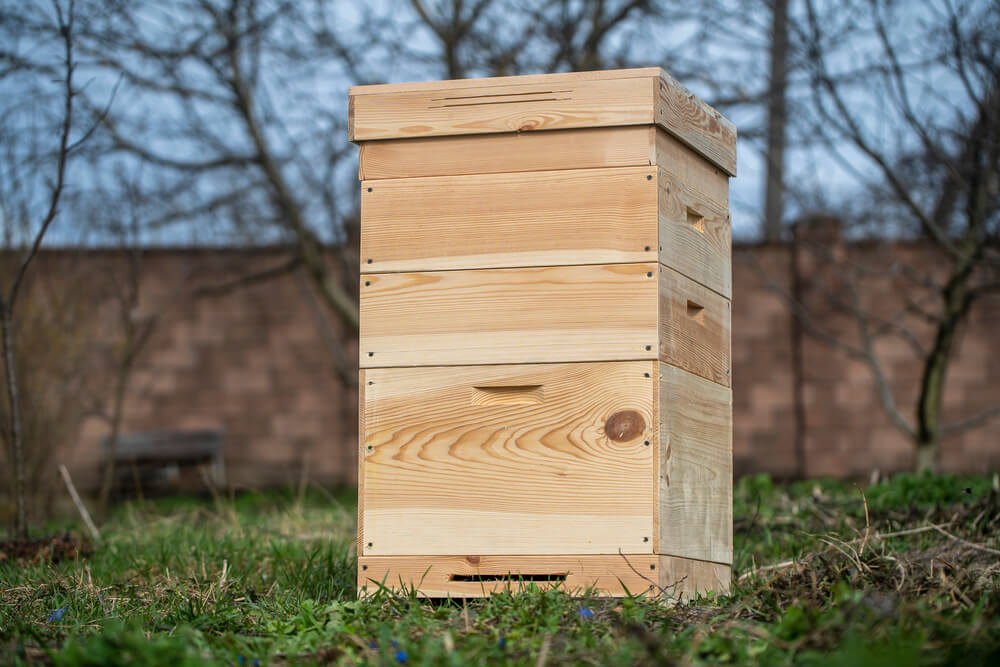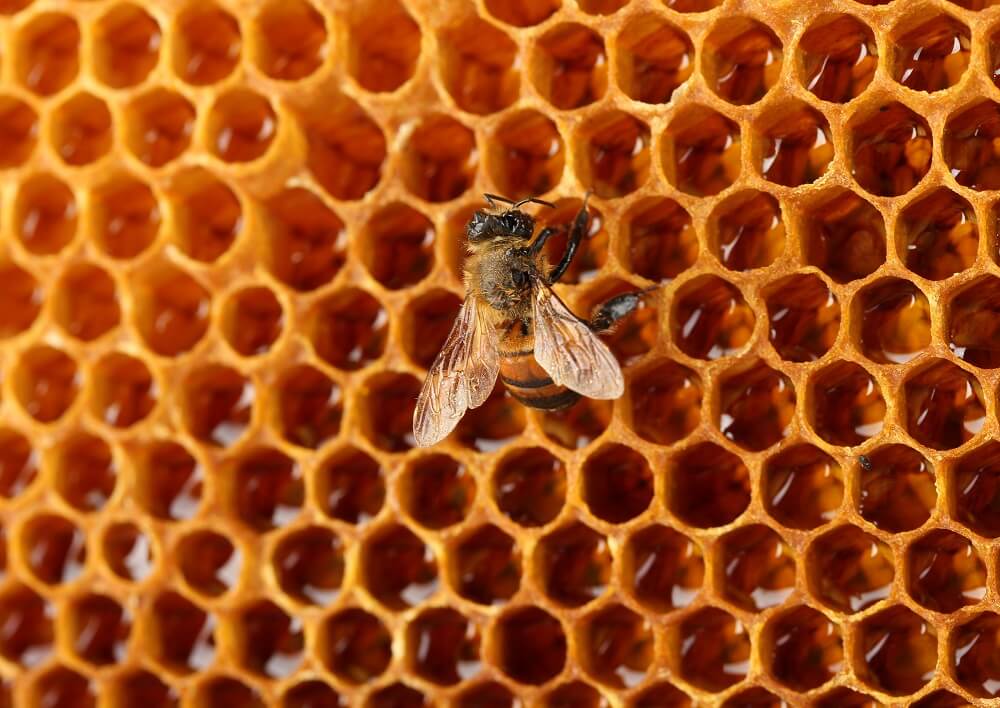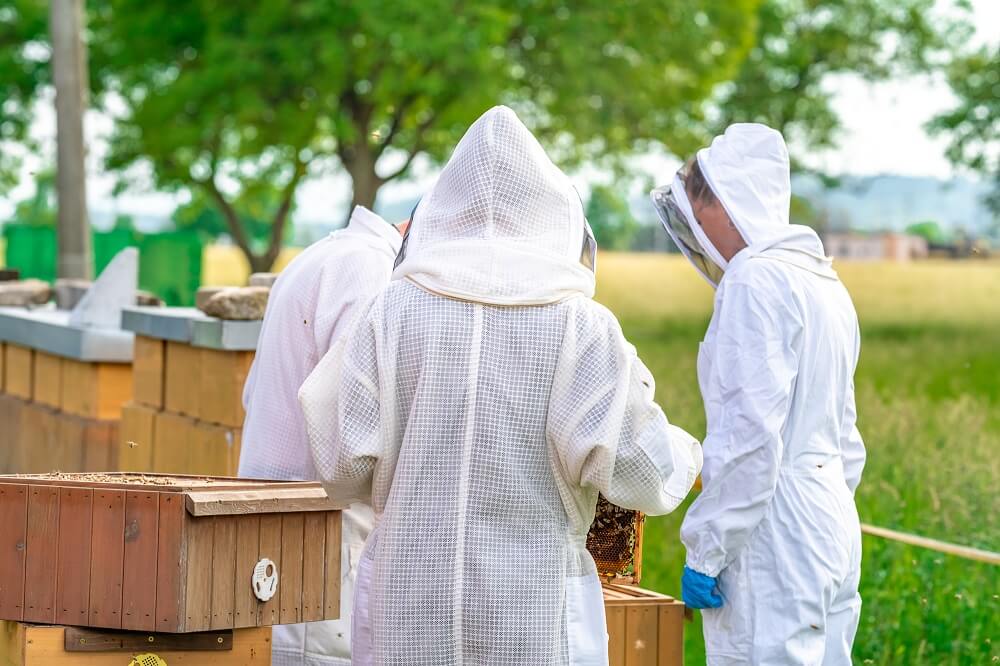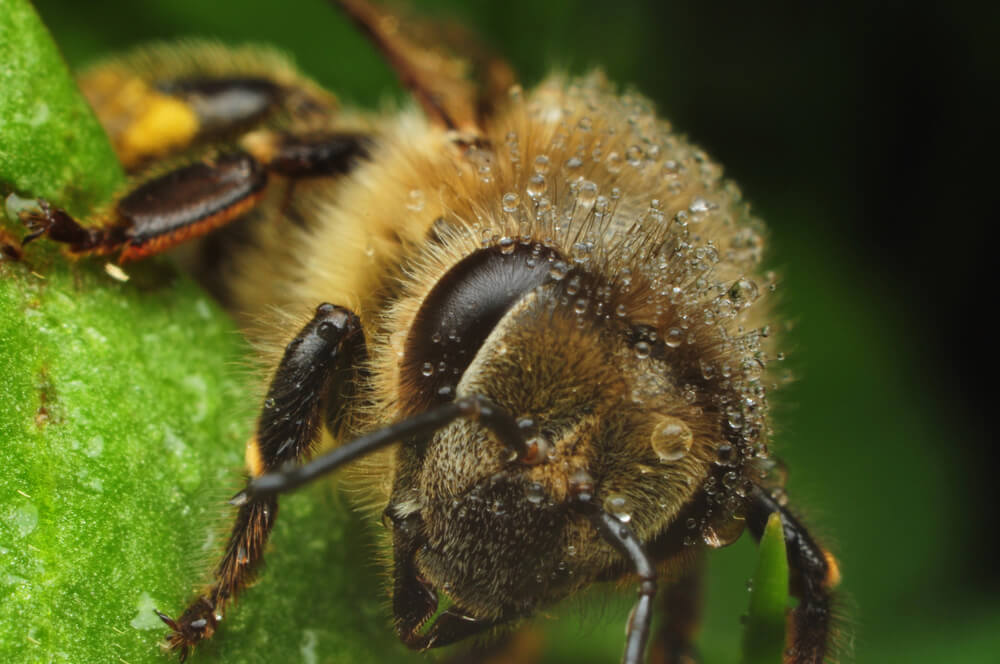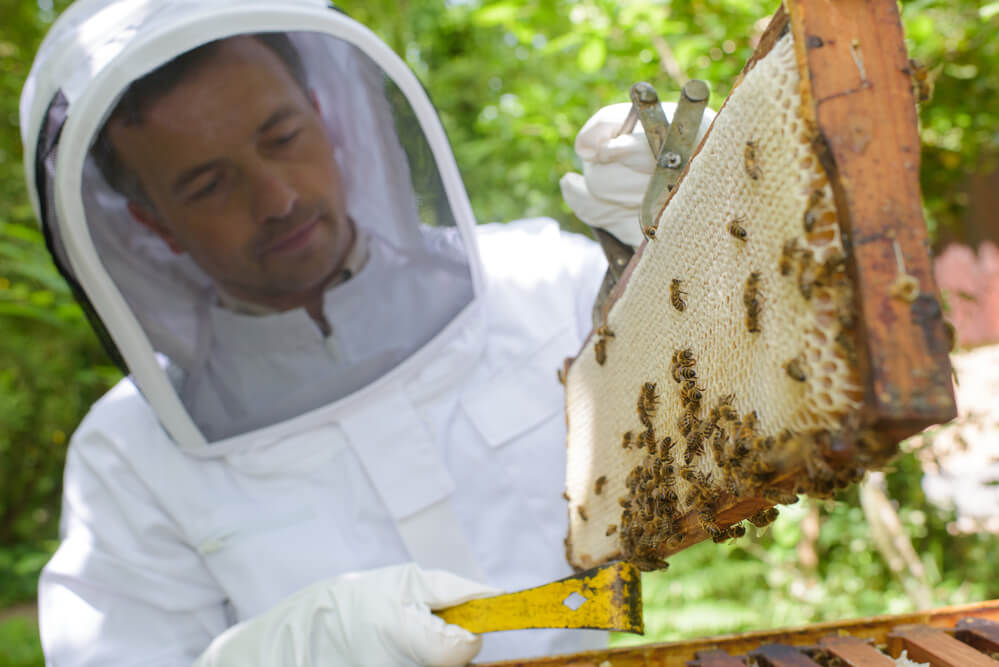Table of Contents:
10-Frame Langstroth Hive Dimensions
We’ve provided three units of measurement for the Langstroth hive. Click the one you need:
Langstroth hives can be measured both outside and inside. Naturally, the outside of the hive is slightly larger than the inside.
In inches, the inside Langstroth dimensions are (Length x Width x Height):
- Shallow boxes: 18 3⁄8” x 14 3⁄4” x 5 11⁄16”
- Medium boxes: 18 3⁄8” x 14 3⁄4” x 6 5⁄8”
- Deep boxes: 18 3⁄8” x 14 3⁄4” x 9 ⅝”
Inside dimensions are the most accurate way to measure a Langstroth hive. Outside dimensions will vary depending on the thickness of the wood used to build the hive.
In inches, the outside Langstroth dimensions are (Length x Width x Height):
- Shallow boxes: 19 ⅞” x 16″ x 5 ⅞”
- Medium boxes: 19 ⅞” x 16″ x 6 ⅝”
- Deep boxes: 19 ⅞” x 16″ x 9 ⅝”
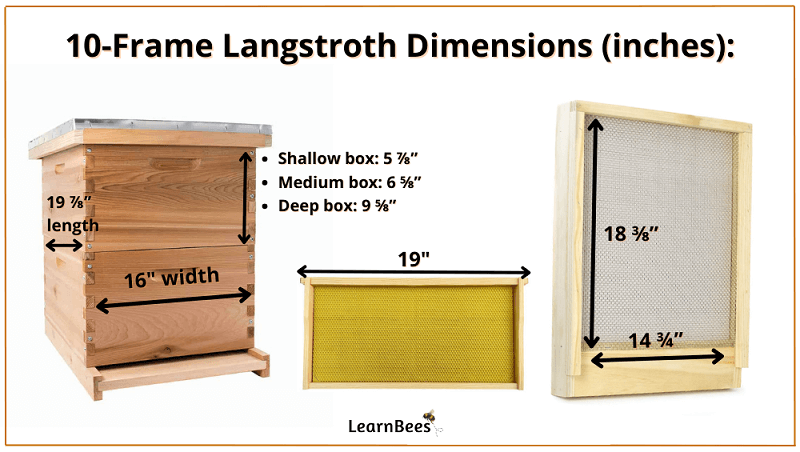
There may be slight variations among Langstroth hives, depending upon the manufacturer. However, all the measurements will be very close to the ones listed above.
For example, a manufacturer might make their hives 20″ long instead of 19 ⅞”. The difference here isn’t much, so beekeepers don’t have to worry about their frames fitting incorrectly. Thus, beekeepers can safely buy different frames from many suppliers.
Now you might be wondering:
What are the Langstroth hive dimensions in centimeters and millimeters?
In centimeters, the inside Langstroth dimensions are (Length x Width x Height):
- Shallow boxes: 46.67cm x 37.47cm x 14.45cm
- Medium boxes: 46.67cm x 37.47cm x 16.83cm
- Deep boxes: 46.67cm x 37.47cm x 24.45cm
In centimeters, the outside Langstroth dimensions are (Length x Width x Height):
- Shallow boxes: 50.48cm x 40.64cm x 14.92cm
- Medium boxes: 50.48cm x 40.64cm x 16.83cm
- Deep boxes: 50.48cm x 40.64cm x 24.45cm
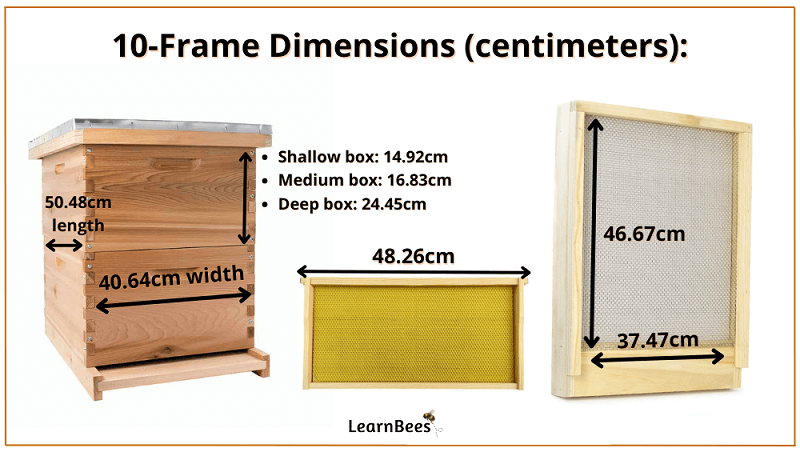
In millimeters, the inside Langstroth dimensions are (Length x Width x Height):
- Shallow boxes: 466.73mm x 374.65mm x 144.46mm
- Medium boxes: 466.73mm x 374.65mm x 168.28mm
- Deep boxes: 466.73mm x 374.65mm x 244.48mm
In millimeters, the outside Langstroth dimensions are (Length x Width x Height):
- Shallow boxes: 504.83mm x 406.4mm x 149.23mm
- Medium boxes: 504.83mm x 406.4mm x 168.28mm
- Deep boxes: 504.83mm x 406.4mm x 244.48mm
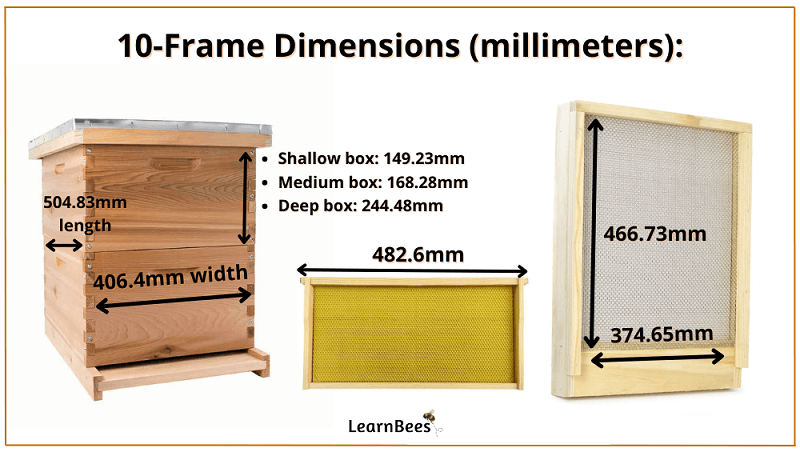
8-Frame Langstroth Hive Dimensions
We’ve provided three units of measurement for Langstroth hives. Click the one you need:
As mentioned, Langstroth hives are measured both externally and internally. Naturally, the outside of the hive is bigger than the inside.
In inches, the inside Langstroth dimensions are (Length x Width x Height):
- Shallow boxes: 18 3⁄8” x 12 1⁄4” x 5 11⁄16”
- Medium boxes: 18 3⁄8” x 12 1⁄4” x 6 5⁄8”
- Deep boxes: 18 3⁄8” x 12 1⁄4” x 9 ⅝”
In inches, the outside Langstroth dimensions are (Length x Width x Height):
- Shallow boxes: 19 ⅞” x 14″ x 5 ⅞”
- Medium boxes: 19 ⅞” x 14″ x 6 ⅝”
- Deep boxes: 19 ⅞” x 14″ x 9 ⅝”
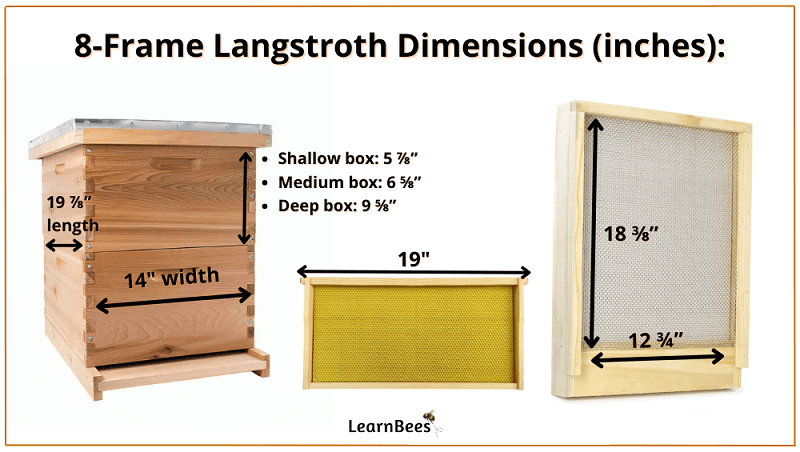
In centimeters, the inside Langstroth dimensions are (Length x Width x Height):
- Shallow boxes: 46.67cm x 31.12cm x 14.45cm
- Medium boxes: 46.67cm x 31.12cm x 16.83cm
- Deep boxes: 46.67cm x 31.12cm x 24.45cm
In centimeters, the outside Langstroth dimensions are (Length x Width x Height):
- Shallow boxes: 50.48cm x 35.56cm x 14.92cm
- Medium boxes: 50.48cm x 35.56cm x 16.83cm
- Deep boxes: 50.48cm x 35.56cm x 24.45cm
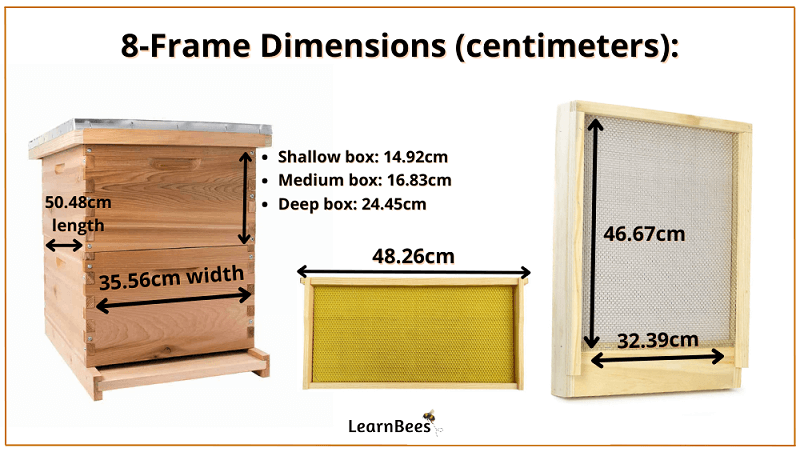
In millimeters, the inside Langstroth dimensions are (Length x Width x Height):
- Shallow boxes: 466.73mm x 311.15mm x 144.46mm
- Medium boxes: 466.73mm x 311.15mm x 168.28mm
- Deep boxes: 466.73mm x 311.15mm x 244.48mm
In millimeters, the outside Langstroth dimensions are (Length x Width x Height):
- Shallow boxes: 504.83mm x 355.6mm x 149.23mm
- Medium boxes: 504.83mm x 355.6mm x 168.28mm
- Deep boxes: 504.83mm x 355.6mm x 244.48mm
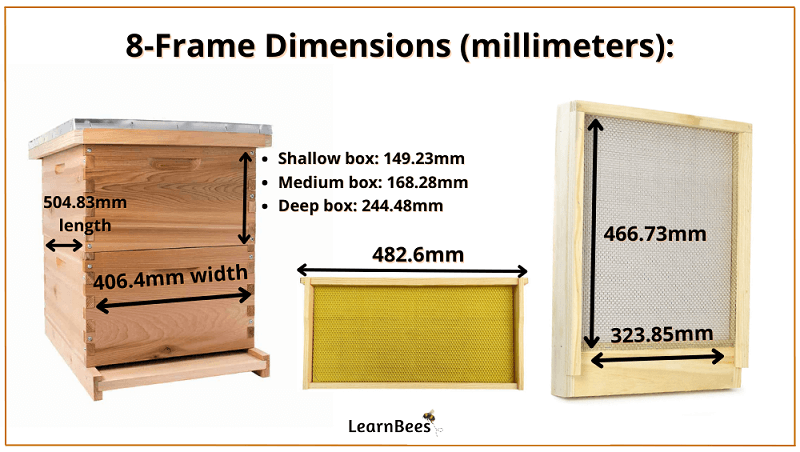
What Size Box Should I Use?
Most beekeepers use medium and deep boxes. Deep boxes are often used for brood, and medium boxes are often used for honey supers.
With that said, the boxes you should use will depend on your physical strength.
When full of honey, your 10-frame boxes can weigh:
- Shallow: 30 to 40 pounds
- Medium: 40 to 50 pounds
- Deep: 70 to 90 pounds
When full of honey, your 8-frame boxes can weigh:
- Shallow: 32 pounds
- Medium: 40 pounds
- Deep: 65 pounds
As you can tell, medium and deep boxes can be extremely heavy. The weight significantly adds up if you’re working in the hot sun and lifting multiple boxes. You have to keep this in mind before purchasing or building deep boxes.
Our suggestion?
Beekeeping is a hobby that should be enjoyed, so pick boxes that won’t strain you too much.
Remember that you’ll be working in the summer when you’re more likely to get hot, sweaty, and tired. If you wear a beekeeping suit, you’re even more likely to get hot.
The advantage of using larger boxes is that you can harvest more honey per box. However, this may hurt your knees and back later on.
There is no right or wrong answer – it’s a matter of strength and personal preference.
FAQs on Langstroth Hive Dimensions
- How heavy is a 10-frame beehive?
- Which is better – an 8-frame or 10-frame beehive?
- How many frames fit in a 10-frame hive?
- How many frames fit in an 8-frame hive?
- What size is a shallow Langstroth frame?
- What size is a medium Langstroth frame?
- What size is a deep Langstroth frame?
- How many brood frames should a hive have?
- How thick should the hive walls be?
- What are the bottom board dimensions?
- What are the Langstroth beehive dimensions by country?
- Should I make the measurements accurate?
How heavy is a 10-frame beehive?
10-frame beehives can be very heavy. 10-frame boxes that are full of honey can weigh:
- Shallow: 30 to 40 pounds
- Medium: 40 to 50 pounds
- Deep: 70 to 90 pounds
—> Go back to the FAQs on Langstroth hive dimensions
More to Explore:
Which is better – an 8-frame or 10-frame beehive?
Both the 8-frame and 10-frame beehives have advantages and disadvantages. One isn’t better than the other, it just comes down to personal preference and strength.
For instance, a key advantage of 10-frame hives is that you can potentially harvest more honey because they hold more.
The downside to 10-frame boxes is that lifting these heavy boxes can put a serious strain on your body. This is especially true if you’ve been beekeeping for several years. Over time, the strain can add up.
The main advantage of 8-frame boxes is that they’re lighter. This allows you to work more slowly and methodically without putting too much pressure on yourself. You’ll decrease your chances of being sore the next day.
Of course, the disadvantage of 8-frame boxes is that you’ll usually collect less honey because the boxes don’t hold as much.
—> Go back to the FAQs on Langstroth hive dimensions
More to Explore:
How many frames fit in a 10-frame hive?
A 10-frame hive will hold ten frames.
—> Go back to the FAQs on Langstroth hive dimensions
More to Explore:
How many frames fit in an 8-frame hive?
An 8-frame hive will hold eight frames.
—> Go back to the FAQs on Langstroth hive dimensions
More to Explore:
- How Many Bees Are in a Hive?
- What is Backyard Beekeeping?
- Honey Extractors 101: Everything You Need to Know
What size is a shallow Langstroth frame?
The dimensions for a shallow frame is 19”x 1 1/16”x 5 3⁄8″.
—> Go back to the FAQs on Langstroth hive dimensions
More to Explore:
What size is a medium Langstroth frame?
The dimensions for a medium frame are 19” x 1 1/16” x 6 ¼”
—> Go back to the FAQs on Langstroth hive dimensions
More to Explore:
What size is a deep Langstroth frame?
The dimensions for a deep frame are 19” x 1 1/16” x 9 ⅛”.
—> Go back to the FAQs on Langstroth hive dimensions
How many brood frames should a hive have?
Most beekeepers use ten frames in the brood boxes. Ten frames provide more area for the brood nest.
However, sometimes beekeepers will use nine frames instead of ten.
Why? There are two main reasons:
- Putting ten frames in the brood box can become cramped, making hive inspections more difficult. You can try using nine frames in the center of the brood box and leave a bit of space on the sides. Push the first frame to the empty space, then pick it up. From there, each frame can be pushed over to the side and picked up. This reduces the chance of accidentally squishing your queen.
- Using nine frames allows you to have dummy boards on each side. This reduces the likelihood of swarming by giving bees more space. It also keeps the hive cooler in the summer and warmer in the winter.
—> Go back to the FAQs on Langstroth hive dimensions
How thick should the hive walls be?
Most Langstroth hives have 3⁄4” thick walls.
With that said, there is no rule set in stone for how thick the walls should be. However, the walls will be thicker if you’re using a polystyrene foam or polyurethane hive.
—> Go back to the FAQs on Langstroth hive dimensions
What are the bottom board dimensions?
The bottom board of a Langstroth should go beyond the hive body, which gives an entrance and base for the rest of the hive. The sideboards should be roughly 22” x 16” x 2.8” for a 10-frame and 22″ x 14″ x 2.8″ for an 8-frame.
—> Go back to the FAQs on Langstroth hive dimensions
What are the Langstroth beehive dimensions by country?
Langstroths are about the same size worldwide. However, there may be slight differences. Here are a few examples of Langstroth dimensions by country:
| Country | Inside Width | Inside Length | Brood Depth | Super Depth |
|---|---|---|---|---|
| Australia | 362 | 464 | 241 | 168 |
| Canada | 380 | 469 | 241 | 168 |
| Denmark | 374 | 463 | 240 | 165 |
| New Zealand | 362 | 464 | 241 | 184 |
| United Kingdom | 370 | 464 | 242 | 146 |
—> Go back to the FAQs on Langstroth hive dimensions
Should I make the measurements accurate?
You want the measurements to be as close as possible to the ones listed above. This will ensure that all your pieces work together.
You want to be able to fit your new frames in old boxes without an issue.
Additionally, it allows you to buy universal Langstroth supplies from other companies.
